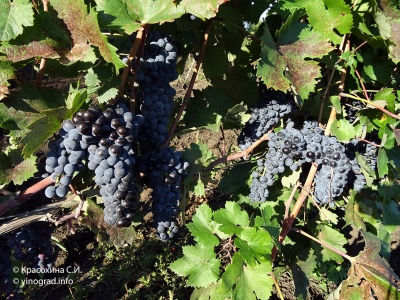
- Authors: I.G. Pavlyuchenko, M.G. Chekmarev State Scientific Institution “All-Russian Scientific Research Institute of Viticulture and Winemaking named after ME AND. Potapenko "Russian Agricultural Academy, Novocherkassk
- Appointment: technical
- Berry color: Navy blue
- Taste: specific, tart
- With bones: Yes
- Ripening period: early middle
- Ripening period, days: 130-135
- Frost resistance, ° C: -18
- Name synonyms: Brittle brush, Pear, Black, Black wine, Tsimlyansky
- Bunch weight, g: 110-160
Many grow grapes on their plots. Currently, different varieties of berries have been bred, one of which is Tsimlyansky Black. In addition to its direct purpose - eating and making wine, culture perfectly protects from the heat. Green canopies are created from the vine, under which it is pleasant to relax in the summer.
Breeding history
Breeders I. G. Pavlyuchenko and M. G. Chekmareva at the State Scientific Institution “All-Russian Scientific Research Institute of Viticulture and Winemaking named after V.I. Ya. I. Potapenko ”developed a new variety by crossing Plechistik and White Kokura. The work was carried out on the basis of the Russian Agricultural Academy in Novocherkassk. The new variety was named Tsimlyansky Black.
In addition to the main name, grapes are called:
Black wine;
A fragile brush;
Black;
Grushev;
Tsimlyansky.
The new variety was allowed for use by gardeners in 1959.
Geography of distribution
The Tsimlyansky Black variety is grown in the wine-growing regions of the Kuban. Delicious grapes grow on the Taman Peninsula. The berry also grows in the Rostov region - the Don Valley, in the Krasnodar Territory, Crimea, in the North Caucasus.
Description
Tsimlyansky Black is a red grape variety for technical purposes. Lyrate leaves have a three- or five-lobed shape with pointed edges. The color is dark green with a grayish tint. A bush with medium vigor. It can reach a height of 5 meters.
Ripening period
The growing season is no more than 135 days. Tsimlyansky Black belongs to the early middle varieties, and the fruits ripen at the end of summer.
Bunches
The shape of the brush is cylindrical-conical, medium-dense. On average, the weight of a bunch ranges from 110 to 160 grams. The bunch rests on a thin, fragile leg and breaks easily. Hence the name Fragile Brush.
Berries
The dark deep blue color of the berries gives the impression that they are black. The grapes grow to medium size. The size of one berry is 13.3x13.1 mm. One fruit weighs 1.0-1.3 grams. Most often rounded, less often weakly oval. Short sharp umbilical cord in the form of a thorn, no more than 1 mm.
Taste
Under the skin of medium density there is a cartilaginous pulp with two bones inside. The taste is specific, tart with a velvety thorny-chocolate aftertaste. The sugar content is 210 g / dm3. Acidity 7.8 g / dm.
Yield
The vine ripens well. The percentage of fruitful shoots is 70. The yield of the Tsimlyansky Black variety with good agricultural technology can reach from 40 to 60 centners / ha. In an arid region, the value decreases to 30-45 c / ha. The fruiting factor of shoots is 0.6-1.0.


Growing features
Tsimlyansky Black is actively developing with good lighting and support. Grapes are afraid of drafts, so you need to choose a place with less influence of northern winds.
Landing
The new cultivar prefers soil rich in trace elements and loose soil. The best option is sandy loam, loamy soil. The pits are made deep up to 80 cm. Humus must be placed on the bottom. The distance between the bushes must be left at least 1.5 meters.

Pollination
The flower type is bisexual. To enhance pollination, it is recommended to plant the autochthonous (aboriginal) variety Plechistik next to the Tsimlyansky Black grape.
Pruning
Regular pruning of 5 buds every year is important. In this case, the bush is given the correct shape.

Watering
This variety has high rates of smoke and gas resistance. The plant easily withstands heat and drought. In such conditions, sugar content is gaining faster. Watering is carried out in spring and autumn to protect the roots from freezing:
in the first year of planting, seedlings are watered in the evening once a week from 5 to 20 liters per bush;
after a month, watering is reduced to once every two weeks;
after the berries ripen, watering is stopped and the soil is moistened in late autumn.


Top dressing
Tsimlyansky Black requires mineral and organic fertilizers. Simple minerals include ammonium nitrate and potassium salt. The complex is nitrophoska. You can use special ready-made complex fertilizers for grapes.
Frost resistance and the need for shelter
The Tsimlyansky Black variety can withstand frosts down to -18 ° С. At lower temperatures, cover the plant and create another layer of snow on top. If the root system suffers from frost, in the future the grapes will shed their buds.

Diseases and pests
Tsimlyansky Black grapes are strongly affected by mildew. Has a weak resistance to powdery mildew. Therefore, it is imperative to carry out a set of measures to prevent diseases of this culture.

If a grape is exposed to any disease or insect, this always affects its appearance.
Storage
Wines made from the Tsimlyansky Black variety can be stored in a barrel for about 2 years. With this storage method, the wine becomes better. Due to the high percentage of sugar content of the grapes of this variety, blends with more acidic varieties are created.
Review overview
Tsimlyansky Black grape is one of the best wine varieties, but it is demanding to care for. Subject to all the conditions for proper care and disease prevention measures, it will bring a big harvest.The taste of wine made from this variety cannot be compared to any other. All efforts to grow Tsimlyansky Black grapes will pay off with a rich harvest.











































































